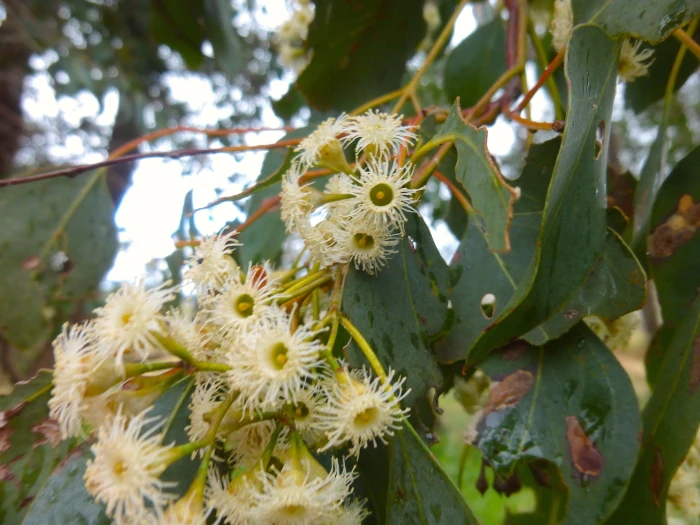Red Box
(Eucalyptus polyanthemos)
Red Box (Eucalyptus polyanthemos)
/
/

Kiri Bee
CC BY 4.0
Image By:
Kiri Bee
Recorded By:
Copyright:
CC BY 4.0
Copyright Notice:
Photo by: Kiri Bee | License Type: CC BY 4.0 | License URL: http://creativecommons.org/licenses/by/4.0/ | Rights Holder: Kiri Bee | Publisher: iNaturalist | Date Created: 2020-09-23T03:08:01-07:00 |





























































Estimated Native Range
Climate Requirements
| • Precipitation | 27" - 33" |
| • High Temp. | 77°F - 87°F |
| • Low Temp. | 33°F - 41°F |
Summary
Eucalyptus polyanthemos, commonly known as Red Box, is a small to medium-sized evergreen tree native to the grassy woodlands and dry sclerophyll forests of eastern Australia. It is adaptable to a range of habitats within its native range, including slopes and plains. This species typically grows to a height of 20 meters (66 feet) and is recognized by its fibrous or flaky bark on the trunk and larger branches, with smooth mottled greyish, cream-coloured, and yellow bark above, or sometimes smooth bark throughout. The Red Box has a distinctive domed canopy of greyish foliage, with juvenile leaves that are broadly egg-shaped to round, and adult leaves that are lance-shaped, egg-shaped, or almost round. It produces flower buds in groups of seven, and its white flowers bloom in October and November, which corresponds to spring in Australia. The woody fruit is barrel-shaped to conical, measuring 3–6 mm in length and width.
The Red Box is valued for its drought tolerance and ability to thrive in a variety of soil types, making it a suitable choice for urban planting, border planting, and as a windbreak in rural landscapes. It is also appreciated for its ornamental white flowers and attractive bark. In cultivation, it requires full sun, low water once established, and well-drained soils. It can tolerate a minimum temperature of -10 °C (15 °F). While it is generally slow-growing, its growth rate can be enhanced with improved soil and irrigation during the first two years. The species is resistant to Armillaria root rot but is potentially invasive outside its native range, so caution is advised when planting it in non-native areas.CC BY-SA 4.0
The Red Box is valued for its drought tolerance and ability to thrive in a variety of soil types, making it a suitable choice for urban planting, border planting, and as a windbreak in rural landscapes. It is also appreciated for its ornamental white flowers and attractive bark. In cultivation, it requires full sun, low water once established, and well-drained soils. It can tolerate a minimum temperature of -10 °C (15 °F). While it is generally slow-growing, its growth rate can be enhanced with improved soil and irrigation during the first two years. The species is resistant to Armillaria root rot but is potentially invasive outside its native range, so caution is advised when planting it in non-native areas.CC BY-SA 4.0
Plant Description
- Plant Type: Tree
- Height: 15-45 feet
- Width: 18-30 feet
- Growth Rate: Moderate
- Flower Color: White
- Flowering Season: Spring
- Leaf Retention: Evergreen
Growth Requirements
- Sun: Full Sun
- Water: Low
- Drainage: Medium, Fast
Common Uses
Bee Garden, Bird Garden, Butterfly Garden, Drought Tolerant, Fragrant, Hummingbird Garden, Low Maintenance, Street Planting
Natural Habitat
Grassy woodlands and dry sclerophyll forests of eastern Australia
Other Names
Common Names: Redbox, Silverdollareukalyptus
Scientific Names: Eucalyptus polyanthemos, Eucalyptus polyanthema
GBIF Accepted Name: Eucalyptus polyanthemos Schauer